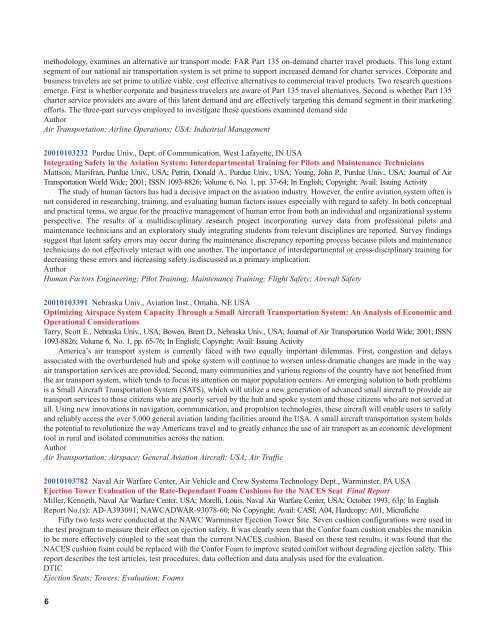Scientific and Technical Aerospace Reports Volume 39 November ...
Scientific and Technical Aerospace Reports Volume 39 November ...
Scientific and Technical Aerospace Reports Volume 39 November ...
Create successful ePaper yourself
Turn your PDF publications into a flip-book with our unique Google optimized e-Paper software.
methodology, examines an alternative air transport mode: FAR Part 135 on-dem<strong>and</strong> charter travel products. This long extant<br />
segment of our national air transportation system is set prime to support increased dem<strong>and</strong> for charter services. Corporate <strong>and</strong><br />
business travelers are set prime to utilize viable, cost effective alternatives to commercial travel products. Two research questions<br />
emerge. First is whether corporate <strong>and</strong> business travelers are aware of Part 135 travel alternatives. Second is whether Part 135<br />
charter service providers are aware of this latent dem<strong>and</strong> <strong>and</strong> are effectively targeting this dem<strong>and</strong> segment in their marketing<br />
efforts. The three-part surveys employed to investigate these questions examined dem<strong>and</strong> side<br />
Author<br />
Air Transportation; Airline Operations; USA; Industrial Management<br />
20010103232 Purdue Univ., Dept. of Communication, West Lafayette, IN USA<br />
Integrating Safety in the Aviation System: Interdepartmental Training for Pilots <strong>and</strong> Maintenance Technicians<br />
Mattson, Marifran, Purdue Univ., USA; Petrin, Donald A., Purdue Univ., USA; Young, John P., Purdue Univ., USA; Journal of Air<br />
Transportation World Wide; 2001; ISSN 1093-8826; <strong>Volume</strong> 6, No. 1, pp. 37-64; In English; Copyright; Avail: Issuing Activity<br />
The study of human factors has had a decisive impact on the aviation industry. However, the entire aviation system often is<br />
not considered in researching, training, <strong>and</strong> evaluating human factors issues especially with regard to safety. In both conceptual<br />
<strong>and</strong> practical terms, we argue for the proactive management of human error from both an individual <strong>and</strong> organizational systems<br />
perspective. The results of a multidisciplinary research project incorporating survey data from professional pilots <strong>and</strong><br />
maintenance technicians <strong>and</strong> an exploratory study integrating students from relevant disciplines are reported. Survey findings<br />
suggest that latent safety errors may occur during the maintenance discrepancy reporting process because pilots <strong>and</strong> maintenance<br />
technicians do not effectively interact with one another. The importance of interdepartmental or cross-disciplinary training for<br />
decreasing these errors <strong>and</strong> increasing safety is discussed as a primary implication.<br />
Author<br />
Human Factors Engineering; Pilot Training; Maintenance Training; Flight Safety; Aircraft Safety<br />
20010103<strong>39</strong>1 Nebraska Univ., Aviation Inst., Omaha, NE USA<br />
Optimizing Airspace System Capacity Through a Small Aircraft Transportation System: An Analysis of Economic <strong>and</strong><br />
Operational Considerations<br />
Tarry, Scott E., Nebraska Univ., USA; Bowen, Brent D., Nebraska Univ., USA; Journal of Air Transportation World Wide; 2001; ISSN<br />
1093-8826; <strong>Volume</strong> 6, No. 1, pp. 65-76; In English; Copyright; Avail: Issuing Activity<br />
America’s air transport system is currently faced with two equally important dilemmas. First, congestion <strong>and</strong> delays<br />
associated with the overburdened hub <strong>and</strong> spoke system will continue to worsen unless dramatic changes are made in the way<br />
air transportation services are provided. Second, many communities <strong>and</strong> various regions of the country have not benefited from<br />
the air transport system, which tends to focus its attention on major population centers. An emerging solution to both problems<br />
is a Small Aircraft Transportation System (SATS), which will utilize a new generation of advanced small aircraft to provide air<br />
transport services to those citizens who are poorly served by the hub <strong>and</strong> spoke system <strong>and</strong> those citizens who are not served at<br />
all. Using new innovations in navigation, communication, <strong>and</strong> propulsion technologies, these aircraft will enable users to safely<br />
<strong>and</strong> reliably access the over 5,000 general aviation l<strong>and</strong>ing facilities around the USA. A small aircraft transportation system holds<br />
the potential to revolutionize the way Americans travel <strong>and</strong> to greatly enhance the use of air transport as an economic development<br />
tool in rural <strong>and</strong> isolated communities across the nation.<br />
Author<br />
Air Transportation; Airspace; General Aviation Aircraft; USA; Air Traffic<br />
20010103782 Naval Air Warfare Center, Air Vehicle <strong>and</strong> Crew Systems Technology Dept., Warminster, PA USA<br />
Ejection Tower Evaluation of the Rate-Dependant Foam Cushions for the NACES Seat Final Report<br />
Miller, Kenneth, Naval Air Warfare Center, USA; Morelli, Louis, Naval Air Warfare Center, USA; October 1993; 63p; In English<br />
Report No.(s): AD-A<strong>39</strong>3091; NAWCADWAR-93078-60; No Copyright; Avail: CASI; A04, Hardcopy; A01, Microfiche<br />
Fifty two tests were conducted at the NAWC Warminster Ejection Tower Site. Seven cushion configurations were used in<br />
the test program to measure their effect on ejection safety. It was clearly seen that the Confor foam cushion enables the manikin<br />
to be more effectively coupled to the seat than the current NACES cushion. Based on these test results, it was found that the<br />
NACES cushion foam could be replaced with the Confor Foam to improve seated comfort without degrading ejection safety. This<br />
report describes the test articles, test procedures, data collection <strong>and</strong> data analysis used for the evaluation.<br />
DTIC<br />
Ejection Seats; Towers; Evaluation; Foams<br />
6
















